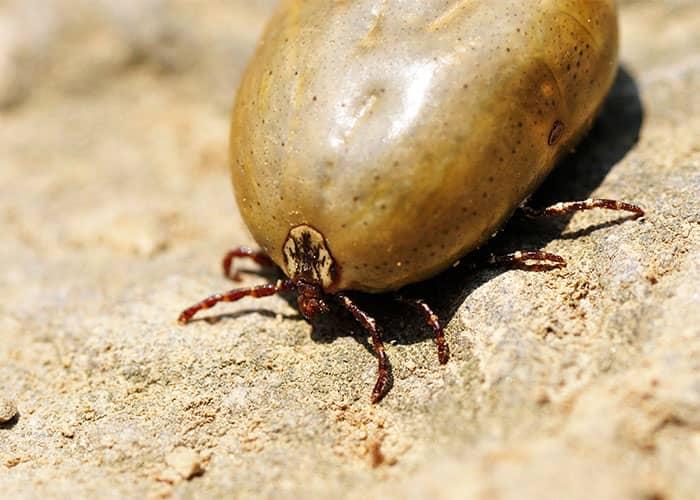What do brown dog ticks look like?
Adult brown dog ticks have an oval body shape and grow to be about 1/8th of an inch in length; after feeding on a blood meal, they become engorged and increase in size to about ½ an inch. Brown dog ticks are red-brown before feeding; after feeding they turn a gray-blue color.

How do brown dog ticks spread?
Like other tick species, brown dog ticks cannot fly or jump; they move from location to location on the bodies of the host that they are feeding on. After they have completed feeding they fall off their host onto the ground. They will then hide and wait until a new host passes by and crawl onto that host, attach themselves to it, and begin feeding on it. As the host travels to their new location, so does the brown dog tick.
Are brown dog ticks native to Maine?
Not native, brown dog ticks are very rare in Maine; they are usually introduced on the bodies of dogs from other states that are visiting. In Maine, populations of brown dog ticks are generally found around kennels, camp sites, and other areas where dogs are housed together or in close proximity to one another.
Why are brown dog ticks inside?
As their name suggests the brown dog tick’s favorite host is the canine. Dog ticks are often brought inside homes on the bodies of family dogs. Unlike other types of ticks that require damp moist soil for their eggs to develop, brown dog tick eggs can develop on any surface.
In homes brown dog tick eggs are often found along window sills, baseboards, the edges of carpets, and in the cracks of furniture. Brown dog ticks are unique because they can complete their entire life-cycle indoors.
Are brown dog ticks dangerous?
Yes, brown dog ticks can be dangerous because of the diseases that they may spread. Brown dog ticks are known to carry and transmit Rocky Mountain spotted fever (there has never been a case of Rocky Mountain spotted fever reported in Maine).
While deer ticks are known transmitters of Lyme disease in Maine, brown dog ticks are not known to carry Lyme disease.
They can also transmit diseases to your dog that include canine ehrichiosis and canine babesiosis.
How do I get rid of brown dog ticks?
To get rid of ticks that are active around your home, camp, or elsewhere on your property, contact Pine State Pest Solutions. We offer effective tick control in Maine that targets areas where these biting, disease-spreading pests hide and breed.
Brown dog tick prevention tips
To prevent brown dog tick problems, we recommend discussing your concerns with any kennels you may use for your pet and be careful when taking your dog on vacation. Other tick prevention tips include:
-
Any pets, especially dogs and cats that spend time both inside and outside of your home, should be treated with a tick preventative under the guidance of their veterinarian.
-
In addition to a tick preventative, pets should be inspected daily for the presence of ticks on their body; paying special attention to the area behind their ears, the base of their tail, and between their toes.
-
When spending time outside in areas that may harbor ticks, make sure to dress properly: wear long pants, sleeves, and closed toe shoes. Inspect yourself and your clothing for ticks before coming inside.
-
Routinely vacuum and/or mop the areas of your home where your pets spend a lot of time; regularly wash their bedding.
-
Make sure that your lawn is cut short and that wooded or overgrown areas are cut back away from the edge of your property.
